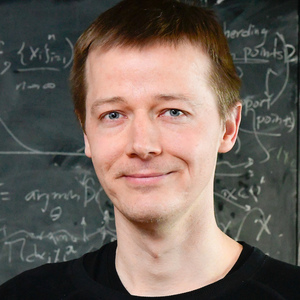Human Pose, Shape and Action
3D Pose from Images
2D Pose from Images
Beyond Motion Capture
Action and Behavior
Body Perception
Body Applications
Pose and Motion Priors
Clothing Models (2011-2015)
Reflectance Filtering
Learning on Manifolds
Markerless Animal Motion Capture
Multi-Camera Capture
2D Pose from Optical Flow
Body Perception
Neural Prosthetics and Decoding
Part-based Body Models
Intrinsic Depth
Lie Bodies
Layers, Time and Segmentation
Understanding Action Recognition (JHMDB)
Intrinsic Video
Intrinsic Images
Action Recognition with Tracking
Neural Control of Grasping
Flowing Puppets
Faces
Deformable Structures
Model-based Anthropometry
Modeling 3D Human Breathing
Optical flow in the LGN
FlowCap
Smooth Loops from Unconstrained Video
PCA Flow
Efficient and Scalable Inference
Motion Blur in Layers
Facade Segmentation
Smooth Metric Learning
Robust PCA
3D Recognition
Object Detection
Probabilistic Algorithms

Probabilistic inference is often thought of as elaborate and intricate – or to put it less charitably: cumbersome and expensive. Work performed in the reporting period shows that probabilistic concepts can, instead, be a driver of computational efficiency: Used to quantify sources of error in composite computations, they can guide the automated design of algorithms, yielding robust outputs and predictions.
Controlling computations and their precision When computations are expensive, it pays off to make them as informative as possible. Riemannian Statistics is an example for the chained computations increasingly common in machine learning: Tasks that are simple in Euclidean space, like Gaussian integrals, become challenging on manifolds, where every evaluation of the integrand involves a complicated simulation to compute geodesics. An ICML paper [] showed that, by finding informative evaluations, adaptive Bayesian quadrature, which casts integration as inference from observations of the integrand, can offer significant gain in wallclock time over traditional Monte Carlo workhorses.
Fast post-hoc uncertainty in deep learning Another recent work addresses the most popular application of uncertainty quantification: Deep nets. Constructing approximate posteriors for deep learning is a long-standing problem. Most contemporary Bayesian deep learning methods aim for carefully crafted, high-quality output. As a result, they tend to be expensive and difficult to use. The classic Laplace approximation offers a more sober approach. It is essentially a second-order Taylor expansion of the empirical risk at the network's point estimate. While this puts some limits on fidelity, it has practical advantages: It leaves the point estimate in place, which practitioners spend considerable time tuning; and it can be constructed post-hoc, even for networks pre-trained by others. In a collaboration with partners in Tübingen, at the ETH, in Cambridge and at Deepmind, we developed the Laplace Library as a practical tool allowing practitioners easy and computationally cheap access to uncertainty on a comprehensive class of deep neural architectures []. The library has already found numerous users, showing the pressing need for uncertainty quantification in deep learning.
Finally, we have explored applications of Bayesian inference algorithms for scientific applications, e.g., to provide fast amortized infererence of the parameters of gravitational wave models [] and in biomedical applications [
].
Members
Publications




